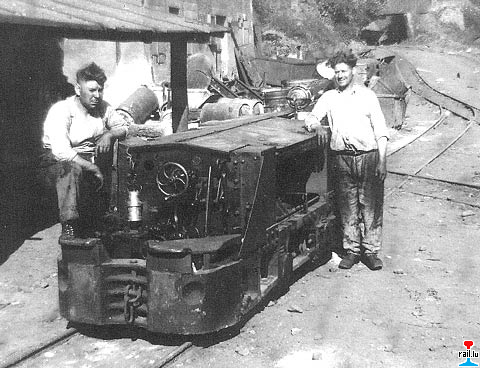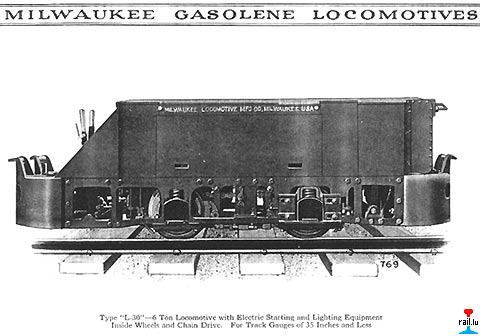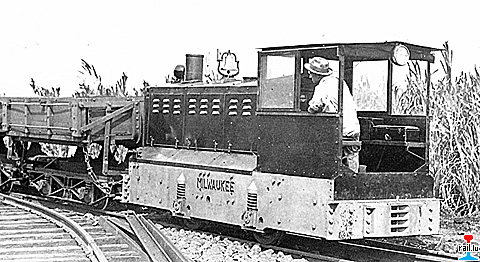Locomotive Milwaukee au Luxembourg
Milwaukee Lokomotive in Luxemburg

|
Milwaukee
Locomotive Mfg
|
Milwaukee
Locomotive in Luxembourg
Locomotive Milwaukee au Luxembourg Milwaukee Lokomotive in Luxemburg |
 |
|

Gazolene locomotive "Milwaukee Locomotive Mfg." de Mines
Frères au Fond-de-Gras (Photo: Théo
Steil)

Gazolene locomotive "Milwaukee Locomotive
Mfg." Type "L30" (Photo collection: Mark J. Landgraf)
Locomotive Milwaukee chez Poeckes
The Milwaukee Locomotive Manufacturing Company was organized
under the laws of Wisconsin in October of 1907 and was in the internal combustion
locomotive manufacturing business since 1909. Milwaukee locomotives production
grew from 2 ton locomotives in the early days to 20 tons in the later years.
Milwaukee only produced 4 wheel locomotives equipped with the gasoline engines
and mechanical transmissions. They were available in gages from 18 to 56.5
inches.
Originally Milwaukee's manufacturing operations were conducted separately, but shortly after, and certainly by 1910, their manufacturing was carried on as a department of the National Brake & Electric Company of Milwaukee, which in turn had been a wholly owned subsidiary of the Westinghouse Air Brake Company since prior to 1910.
On July 19, 1932, Whitcomb Locomotive Company acquired the Milwaukee Locomotive Manufacturing Company from Westinghouse Air Brake Company, in an arrangement whereby Westinghouse became a stockholder in Whitcomb Locomotive Company. This acquisition included the business, it's inventory and the good will of the company. The inventory was completely transferred to the Rochelle plant of Whitcomb and included 30 locomotives ranging in size from 4 to 16 tons, a large stock of repair parts, records, patterns and necessary machine tooling. This was done to insure present and prospective owners of Milwaukee locomotives they would have an uninterrupted, efficient and permanent source of parts and service. Whitcomb also received four completed locomotives that were stored and available for immediate sale on the Pacific Coast.
Milwaukee continued to operate as a subsidiary of Whitcomb for a 3 year period until it's 1935 dissolution by Whitcomb. During this period, Milwaukee completed the construction of, or the rebuilding of about three dozen locomotives. Milwaukee's total lifetime production was certainly less than 1000 locomotives. Their highest construction number issued was 981. From the appearance of the construction numbers being issued on the listing below, one would be led to believe that many of the older H models (introduced in 1924) are being rebuilt and issued new construction numbers. Their Whitcomb era production is as follows:
PSO Model Tons Gauge Date C/N Owner
6075 H-7 7 36" - 740 Atlas Powder, Rblt by WLCo. 2-1934
6102 H-8 8 36" 11-34 769 Lehigh Portland Cement
6052 H-12 12 Std 8-34 872 McClintic - Marshall Corp
6054 H-10 10 24" 7-33 909 Bethlehem Steel
6054 H-10 10 24" 7-33 910 Bethlehem Steel
6042 H-10 10 36" 11-32 911 Gunter Construction Company
6059 H-10 10 Std 9-33 912 Armour Soap Works
6042 H-10 10 36" 4-36 913 Gunter Construction Company, reblt PSO 6138
6050 H-16 16 Std 7-33 914 Imperial Works-Railroad Dept - Oil City, PA
6078 H-16 16 36" 3-34 915 Midvale Company #31 - Nicetown, PA
6110 H-16 16 Std 2-35 916 Gair Cartons Inc
6092 J-4 4 30" 9-34 927 Swift & Company - Fertilizer Works
6045 J-4 4 30" 1-33 929 American Cyanamide & Chemical Company
6090 J-4 4 24" 8-34 934 Columbian Petrol Company, export
6051 H-5 5 36" 7-33 941 Standard Oil of New Jersey - Venezuela
6055 H-4 4 42" 8-33 942 State of Kansas Penitentiary, Dept of Mines
6063 J-4 4 750mm 10-33 948 Ferrocarril Mexicano S.A.
6087 J-4 4 36" 6-34 949 Trojan Powder Company
6092 J-4 4 30" 9-34 950 Swift & Company - Fertilizer Division
6092 J-4 4 30" 9-34 951 Swift & Company - Fertilizer Division
6092 J-4 4 30" 9-34 952 Swift & Company - Fertilizer Division
6106 H-10 10 Std 12-34 953 Faircroft Engineering Company
6062 H-9 9 500mm 10-33 964 Rblt to diesel for Central Coloso of PR
6040 H-6 6 36" 10-32 966 Lakeland Phosphate & Fertilizer
6064 H-6 6 Std 10-32 967 U.S. Indian Service - Neopit, WI
6066 H-6 6 Std 11-33 969 Salinas de Mexico
6060 H-4 4 36" 9-33 970 Giant Powder Company/Atlas Powder #F
6067 H-5 5 36" 11-33 971 Standard Oil of New Jersey - Venezuela
6043 H-5 5 Std 11-32 972 Foster & Creighton Company
6046 H-4 4 Std 5-33 973 E.I. DuPont de Nemours
6090 H-4 4 24" 8-34 974 Columbian Petrol Company, export
6069 H-4 4 36" 11-33 975 E.I. DuPont de Nemours
6058 H-4 4 36" 8-33 978 E.I. DuPont de Nemours
6108 H-4 4 36" 1-35 979 BLW XO-3003 of 1935 exported for Standard Oil
6053 H-8 8 36" 7-33 980 Fred Snare Corp/Lone Star Cement Company
6121 H-4 4 Std 7-35 981 E.I. DuPont de Nemours
The production records of Milwaukee Locomotive were stored at the East Pittsburgh, PA office of Westinghouse Air Brake Company. These records were never turned over to Baldwin or Whitcomb at the time of the sale. Westinghouse is known to have later disposed of these records. I have been unable to locate any construction number listing for Milwaukee locomotives. If anyone has this information, please contact me.
The early W class models were of a crude design that resembled
a wagon having wheels underneath that carried a pan above in which the engine
and transmission were held and a space was provided for the operator. They
had cast steel end sills and individual pedestals that were attached to the
pan. Later W class locomotives utilized cast pans. These locomotives were
of a very rudimentary design. Heavier A & C class locomotives were short
center cab designs, but still utilized the wagon design. In the early years,
Milwaukee used a class designation system that was a Letter followed by a
Horsepower Number. Early Classes included W, A, & C. These were all 4
wheel locomotives equipped with 4 cylinder 4 cycle gasoline engines and had
open chain
drives.
Typical models included:
W-10 a 10 HP, 2 ton locomotive, one speed, 6 MPH maximum, cab optional
W-20 a 20 HP, 3 ton locomotive, one speed, 6 MPH maximum, cab optional
A-25 a 25 HP, 4 ton locomotive, two speeds, 8 MPH maximum, with center cab
C-50 a 50 HP, 8 ton locomotive, 3 speeds, 15 MPH maximum, with center cab
C-75 a 75 HP, 12 ton locomotive, 3 speeds, 15 MPH maximum, with center cab
C-100 a 100 HP, 18 ton locomotive, 3 speeds, 15 MPH maximum, with center cab
Mine type locomotives followed more traditional designs.
Mine type locomotives were classes G, L and M. The M class locomotives were
a medium duty and had cast steel end sills, cast iron side frames, a 4 cylinder
4 cycle engine with vertical cylinders, and a two speed transmission that
provided a maximum speed of 8 MPH. The G class of locomotives are identical
to the M class except their engines had horizontally oriented pistons allowing
for a 34 inch overall height.
The L class were heavy duty locomotives are were the last class designed.
They had an open cast steel bar type side frames and are otherwise similar
to the M class. Typical models included:
M-20 a 20 HP, 4.5 ton locomotive, two speeds, 8 MPH maximum, no cab
M-25 a 25 HP, 5 ton locomotive, two speeds, 8 MPH maximum, no cab
M-35 a 35 HP, 7 ton locomotive, two speeds, 8 MPH maximum, no cab
M-50 a 50 HP, 9.5 ton locomotive, two speeds, 8 MPH maximum, no cab
G-20 a 20 HP, 4 ton locomotive, two speeds, 8 MPH maximum, no cab
L-25 a 25 HP, 5 ton locomotive, two speeds, 7 MPH maximum, cab optional
L-30 a 30 or 35 HP, 6 ton locomotive, two speeds, 8 MPH maximum, no cab, siderod
drive
L-40 a 40 HP, 7 ton locomotive, two speeds, 8 MPH maximum, cab optional, siderod
drive
L-50 a 50 HP, 8 ton locomotive, two speeds, 8.5 MPH maximum, no cab, siderod
drive
L-60 a 60 HP, 12.5 ton locomotive, two speeds, 8.5 MPH max, cab optional,
siderod drive
By about 1920, Milwaukee introduced their Friction Drive
locomotive, a class F-25. This was a 25HP, 4 ton locomotive with Friction
Drive and
a peaked hood and cab. It is believed that this was the first Milwaukee locomotive
to include the new style Modine section core radiator bearing the familiar
Milwaukee name.
In 1924, Milwaukee introduced their new H class. This was the first time that Milwaukee's locomotives took on the appearance of strength and mass. Even the small locomotives had the appearance of strength. This class effectively replaced prior classes W and F. The Class A, C & G locomotives had already been discontinued. The mining classes M and L remained largely unchanged. At this point, they appear to be starting to seriously threaten Whitcomb's customer base.
The new H class ranged in size from 3.5 tons to 25 tons.
These locomotives all included the peaked top Modine sectional core radiators
bearing the Milwaukee name cast across their tops. The entire H class of locomotives
had 4 speed transmissions that drove the wheels using roller chains. This
system allowed for a 12 MPH maximum speed. This entire class of locomotive
all have their wheels inside of the frame. They were also designed so that
the operator sat crosswise
in the cab when in the driving position, giving the operator a clear view
of the track when driving in either direction. Classes H-3, H-4, H-5, H-6,
H-7, H-8, H-9, H-10, H-12, H-14 models had solid cast semi-steel sideframes
attached to reinforced channel iron end sills. The H-15 model had cast steel
open bar style sideframes attached to reinforced channel iron end sills. The
H-16 & H-18 models had cast steel solid sideframes attached to reinforced
channel iron end sills. The H-20 model had cast steel solid sideframes attached
to cast steel end sills.
Typical models included:
H-3 a 40 HP, 3.5 ton locomotive, using a Hercules model O, 4x5" 4 cylinder
engine
H-4 a 40 HP, 4 ton locomotive, using a Hercules model O, 4x5" 4 cylinder
engine
H-5 a 40 HP. 5 ton locomotive, using a Hercules model O, 4x5" 4 cylinder
engine
H-6 a 50 HP, 6 ton locomotive, using a Beaver model JE, 4.75x6" 4 cylinder
engine
H-7 a 50 HP, 7 ton locomotive, using a Beaver model JE, 4.75x6" 4 cylinder
engine
H-8 a 67 HP, 8 ton locomotive, using a Climax model TU, 5.5x7" 4 cylinder
engine
H-9 a 75 HP, 9 ton locomotive, using a Beaver model JD, 4.75x6" 6 cylinder
engine
H-10 a 75 HP, 10 ton locomotive, using a Beaver model JD, 4.75x6" 6 cylinder
engine
H-12 a 104 HP, 12 ton locomotive, using a Climax model RU, 5.5x7" 6 cylinder
engine
H-14 a 104 HP, 14 ton locomotive, using a Climax model RU, 5.5x7" 6 cylinder
engine
H-15 a 130 HP, 15 ton locomotive, using a Beaver model RE 6x7" 6 cylinder
engine
H-16 a 130 HP, 16 ton locomotive, using a Beaver model RE 6x7" 6 cylinder
engine
H-18 a 130 HP, 18 ton locomotive, using a Beaver model RE 6x7" 6 cylinder
engine
H-20 a 130 HP, 20 ton locomotive, using a Beaver model RE 6x7" 6 cylinder
engine
H-25 a 160 HP, 25 ton locomotive, using a Beaver model RY 6.5x7" 6 cylinder
engine
It should be noted that not all of these models were shown in every catalog. i.e. the H-8 appears to have replaced the H-9, and the H-16 appears to have replaced the H-18, etc. It is also believed that no class H-25 locomotives were ever built.
By 1929, Milwaukee introduced their Class J locomotives.
These were an economical alternative to the class H locomotive, but were only
offered in gages between 18" and 42". They used the Hercules 4 cylinder
model OX engine, with it's 4x5" bore & stroke that developed 40 HP
at 1400 RPM. This was directly bolted to a standard four speed heavy duty
truck transmission and in turn created a unit type of construction. This class
of locomotives was offered in J-4 and J-4.5
models (4 tons & 4.5 tons) that were capable of 13 MPH maximum. The frames
were composed of solid cast semi-steel sideframes attached to reinforced channel
iron end sills. This class also used the Modine sectional core radiators bearing
the Milwaukee name cast across their tops.
Mark Landgraf


Military railroads of Hawaii. In a locomotive list prepared many years ago there is a U.S. Army H-12C Milwaukee locomotive with a build date of 1934 and construction number 873. The gentleman who prepared the list did not reference his sources so we are unable to verify any of the information. The only reference information we have is a reprint of a 1930 Milwaukee catalog. The attached photos appear to be identical to the 1930 catalog cut of a H-12 with the exception of four bolt heads in the corners of the side frames. The photos are from the National Archives, Record Group 77, MILITARY CONSTRUCTION FINAL REPORTS, 1934-1938, Box 24A Location: 2159E (entry 94, 1975 PI). These locomotives were used in the construction of Fort Barrette, ca. 1932, and likely remained there to service the two 16 inch guns with powder and shell from the magazines. Since the only difference we can find between the H-12 and the H-14 is the two additional tons and a drawbar pull of 7,000 lbs. at 2 and 4 MPH for the H-14 vice 6,000 lbs. for the H-12, we are of the opinion that the four bolts at the side frame corners are retaining 1,000 lb. cast weights and these photos show Milwaukee H-14s in service.
Jeff Livingston, historian of the Hawaiian Railway Society (HRS), island of Oahu, Hawaii
| Liens / Links |
| Locomotive Workshops / Ateliers de constructions de locomotives / Lokfabriken |
| Mining Railways of Mines Frères / Les chemins de fer de Mines Frères / Erzgrubenbahnen der Gebrüder Mines - Rodange |
| Locomotive Whitcomb au Luxembourg |
| Mining Railways in Luxembourg / Les chemins de fer des Mines au Luxembourg / Erzgrubenbahnen in Luxemburg |
|
Any information or picture completing these pages is welcome! For more information just send us an e-mail. Toute information ou photo pouvant compléter ces pages est la bienvenue! Pour des informations supplémentaires, veuillez nous envoyer simplement un e-mail. Jede Information oder jedes Foto, welche(s) diese Seiten vervollständigen, ist herzlich willkommen! Für mehr Informationen, senden Sie uns einfach ein e-mail. |
 |
Created by / Créé
par / Copyright: jmo
5 jan 2003
|